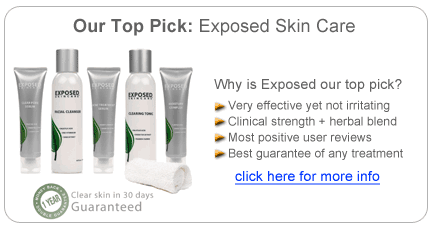There are a few different types of acne, but the most severe is acne vulgaris, better known as cystic acne. This is more common in younger men, but people at any age or gender can experience it. People who are suffering from cystic acne can have scaly red skin, blackheads, whiteheads, pimples, and large papules. Scarring is also common due to the severity of the acne.
Cystic acne usually affects the parts of skin with the most oil production, the back, chest and face. This type of acne usually starts to show up during adolescence, when increases in testosterone usually occur. Most people notice a decrease in the severity of their level of acne by the time they reach their early twenties.
What Causes Cystic Acne?
It appears that acne, especially cystic acne, is hereditary; most people with cystic acne have family members that suffer from it also. The same cause of regular acne is also the root of cystic acne; acne is created when pores become blocked with oil and dead skin cells. At this point, either a blackhead or a whitehead is formed. Inflammation of these can occur due to bacteria, and this is what causes lesions to occur. These lesions are usually what leads to acne scarring.
What can you do to treat it?
There are several different ways that cystic acne can be treated such as: benzoyl peroxide, oral antibiotics, birth control pills, oral retinoids, and topical retinoids.
• Benzoyl peroxide is the most common treatment for cystic acne, it is usually the first thing that is prescribed to treat it. Its side effects are the most mild, usually limited to redness and peeling, but it is also not as strong as some of the other options for treatment.
• Oral antibiotics help to kill the bacteria that causes acne. It has a high success rate and relatively few side effects; however, the treatment is not a permanent solution. People that take oral antibiotics to treat cystic acne will eventually see the bacteria become resistant to the treatment.
• Birth control pills (obviously for women) can help regulate hormones that are causing increased oil production, and limiting oil helps get acne under control. The downsides of this method is that all of the possible side effects associated with birth control are still an issue, even with a lower dosage. Additionally, this does not always completely cure the acne, though it usually does at least reduce it.
• Retinoids are vitamin A derivatives; vitamin A is a major part of skin cell replacement and health. The most common oral retinoid is Accutane (now sold as Isotretinoin). The success rate for Accutane is almost one hundred percent; however, the side effects related to it are extreme and severe. For example, women have to sign contracts stating that they are on, and will continue to be on, two different types of birth control to be prescribed it.
• Topical retinoids, such as Retin-A and Differin, are also highly effective, but do not carry the same type of extreme side effects that Accutane does. But the side effects of topical retinoids are still rather strong. The work essentially as a chemical peel, and people with sensitive or dry skin can have extreme reactions to them. People with normal to oily skin will have the least problems using it, and most side effects go away within a few weeks of using it.

